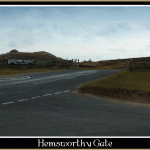
Every day numerous cars, vans and buses thunder across the cattlegrid at Hemsworthy Gate as they travel between Widecombe-in-the-Moor and Bovey Tracy or come up from Ashburton. Today one could easily remark that there is nothing special about the place especially as there is in fact no gate to be seen. But as with any Dartmoor landscape feature there is a story to be told about Hemsworthy Gate.
Firstly the actual placename, If you look at the map extract below you will see that just to the north of the gate is Emsworthy Farm and it could well be that this is where the gate obtained its name after adding the letter ‘H’ at the beginning? Certainly the ‘worthy‘ element of the name would suggest a very early origin to the farm as this is a corruption of the old Anglo Saxon word woröig denoting an enclosed homestead, farm or curtilage. Clarke Hall, p.419. In light of this and the fact that nearby is what originally was a Bronze Age cairn known as ‘Seven Lord’s Lands‘ may well suggest that at least the road running through the gate dates well back into medieval times. Seven Lord’s Lands was in Anglo Saxon times adopted as meeting place of seven manorial bounds where quite possibly regular meetings were held. Again this would tie in with the nearby Anglo Saxon ‘worthy’. Just to confuse things slightly Hemsworthy Gate has at one time also been known by another name. Hemery notes: “As for Hemsworthy Gate, the name is both unauthentic and unused on Dartmoor… and its site still is, always known to the moormen as ‘White Gate’. p.660. This could well be down to the fact that at one-time the actual gate was painted white?
What was the purpose of having a gate located at such a location? Basically moorgates were originally used to stop stop cattle and ponies from straying away from the commons. Which brings us nicely on to the question of when did the gate disappear? The only indication of its demise comes from Hemery when he states that during the Second World War some American troops removed the gateposts. Why? Quite simply because they were trying to drive some tank transporters through the gateway and found it was too narrow to allow them to get through. Their solution was to simply remove the gateposts thus widening the gap. Now whether the gate was replaced after this I know not. What I do know is that just to the left of today’s gateway (when travelling from Widecombe-in-the-Moor) can be seen the original granite gateposts, one now built into the wall and the other lying nearby.
Sitting in the nearby car park the other day I couldn’t help thinking what a brilliant but noisy invention cattle grids are. Imagine if that road was still gated and folks had to open and close it each time and imagine with today’s volume of traffic if you drew the short straw and were the first to open it. You would be stood there ages waiting for the traffic flow to stop long enough to shut the gate and quickly be on your way.
I would say that on Dartmoor there is no other location whereby so many historic and prehistoric features can be found in such close proximity than Hemsworthy Gate. Park in the small car park just west of the gate and 400 metres to the south west are the remains of the prehistoric settlement known as Foale’s Arrishes. Some 80 odd metres to the south east sits Stittleford’s Cross built neatly into the enclosure wall. Alternatively 450 metres to the east are the remnants of the old Hemsworthy tin mine and also 150 metres to the north is the Seven Lord’s Lands cairn. Finally just a few metres from the gate stands a lone waymarker which is incised with the letters M, A, and B. John Hayward in his Dartmoor 365 book suggests that the stone is a waymarker with the letters referring to the direction of travel, i.e. M for Manaton or Moretonhampstead, A for Ashburton and B for Bovey Tracy. p.216. However there is another theory that the stone is a boundstone marking the Ashburton and Manaton boundaries which was erected sometime in the 19th century.

Clark Hall, J. R. 2004. A concise Anglo-Saxon Dictionary. London: University of Toronto Press.
Hayward, J. 1991. Dartmoor 365. Curlew Publications.
Hemery, E. 1983. High Dartmoor. London: Hale Publishing.
 Legendary Dartmoor The many aspects past and present of Dartmoor
Legendary Dartmoor The many aspects past and present of Dartmoor





